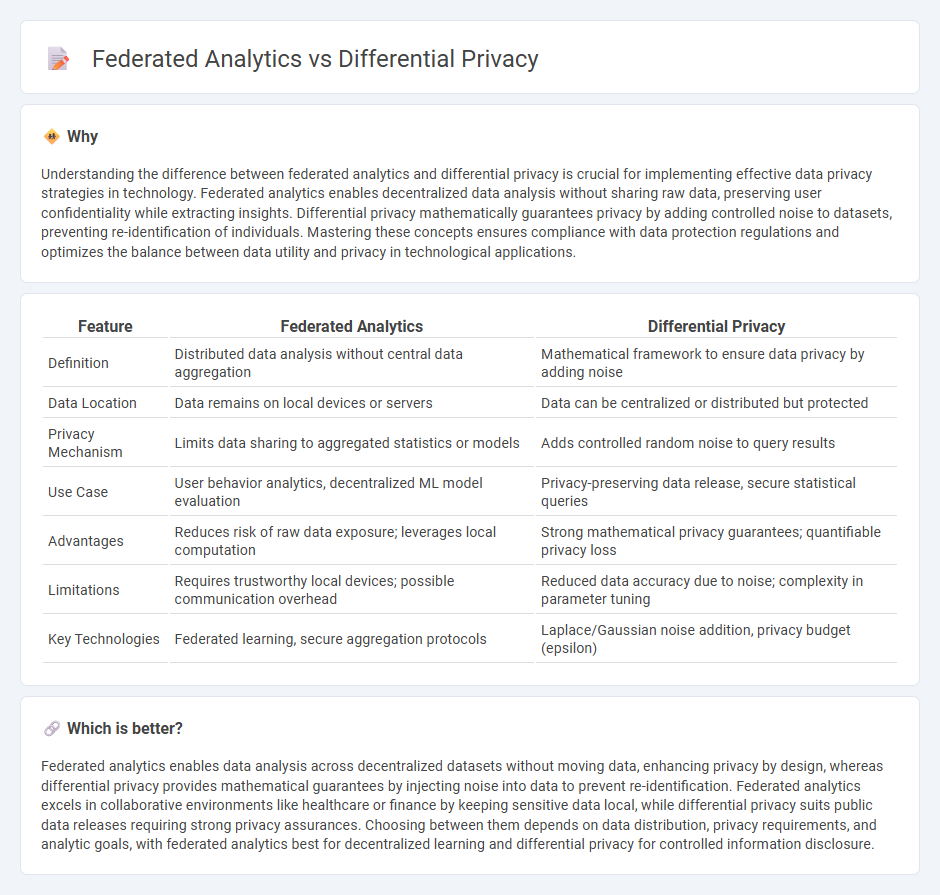
Federated analytics enables data analysis across multiple decentralized devices while keeping raw data localized, enhancing privacy protection. Differential privacy introduces controlled noise to datasets, ensuring individual data points remain unidentifiable within aggregated results. Explore how these privacy-preserving techniques revolutionize data security and analytics.
Why it is important
Understanding the difference between federated analytics and differential privacy is crucial for implementing effective data privacy strategies in technology. Federated analytics enables decentralized data analysis without sharing raw data, preserving user confidentiality while extracting insights. Differential privacy mathematically guarantees privacy by adding controlled noise to datasets, preventing re-identification of individuals. Mastering these concepts ensures compliance with data protection regulations and optimizes the balance between data utility and privacy in technological applications.
Comparison Table
| Feature | Federated Analytics | Differential Privacy |
|---|---|---|
| Definition | Distributed data analysis without central data aggregation | Mathematical framework to ensure data privacy by adding noise |
| Data Location | Data remains on local devices or servers | Data can be centralized or distributed but protected |
| Privacy Mechanism | Limits data sharing to aggregated statistics or models | Adds controlled random noise to query results |
| Use Case | User behavior analytics, decentralized ML model evaluation | Privacy-preserving data release, secure statistical queries |
| Advantages | Reduces risk of raw data exposure; leverages local computation | Strong mathematical privacy guarantees; quantifiable privacy loss |
| Limitations | Requires trustworthy local devices; possible communication overhead | Reduced data accuracy due to noise; complexity in parameter tuning |
| Key Technologies | Federated learning, secure aggregation protocols | Laplace/Gaussian noise addition, privacy budget (epsilon) |
Which is better?
Federated analytics enables data analysis across decentralized datasets without moving data, enhancing privacy by design, whereas differential privacy provides mathematical guarantees by injecting noise into data to prevent re-identification. Federated analytics excels in collaborative environments like healthcare or finance by keeping sensitive data local, while differential privacy suits public data releases requiring strong privacy assurances. Choosing between them depends on data distribution, privacy requirements, and analytic goals, with federated analytics best for decentralized learning and differential privacy for controlled information disclosure.
Connection
Federated analytics enables data analysis across decentralized devices while keeping raw data localized, enhancing privacy by design. Differential privacy introduces mathematical noise to aggregated results, ensuring individual data points remain indistinguishable within shared outputs. Together, they empower secure, privacy-preserving insights without exposing personal information.
Key Terms
Data Aggregation
Differential privacy ensures data aggregation by adding calibrated noise to aggregated results, protecting individual data points while maintaining overall data utility. Federated analytics aggregates insights locally on devices before sending summarized information to a central server, reducing raw data exposure and improving privacy. Explore how these approaches balance privacy and accuracy in data aggregation for deeper insights.
Local Computation
Local computation in differential privacy processes data on individual devices, adding noise to ensure privacy before aggregation, minimizing raw data exposure. Federated analytics performs computations locally but shares only aggregated insights, preserving user privacy without direct data sharing. Explore detailed comparisons to understand which method suits your privacy and analysis needs best.
Privacy Guarantees
Differential privacy ensures privacy by injecting calibrated noise into datasets, providing mathematical guarantees that individual information remains indistinguishable within aggregate data. Federated analytics processes data locally on devices, transmitting only aggregated insights, thereby minimizing exposure of raw user data while enabling large-scale analysis. Explore how these privacy-preserving technologies safeguard sensitive information in diverse applications.
Source and External Links
What Is Differential Privacy? - Differential privacy is a mathematical framework that protects individuals in datasets by ensuring that analyzing or releasing aggregate data does not reveal information about any specific person, primarily by adding carefully calibrated noise to the data.
Differential privacy - Differential privacy (DP) is a rigorous mathematical definition for algorithms that release statistical information from datasets while limiting what can be inferred about any individual, ensuring privacy is maintained even if auxiliary information is available.
Differential Privacy - Apple implements differential privacy by transforming user data on the device before transmission, removing identifiers, and strictly limiting the amount of data any single user can contribute, so that even aggregated statistics cannot be used to identify individuals.
 dowidth.com
dowidth.com